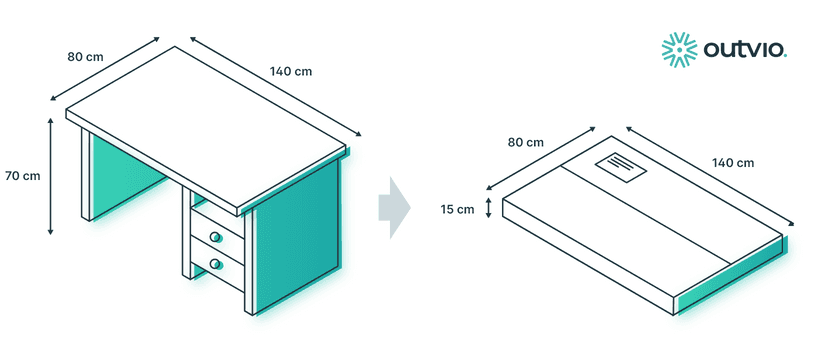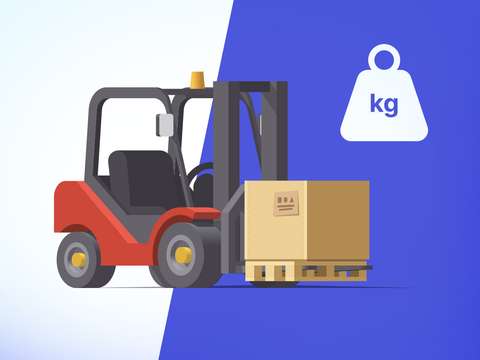If you run an online store, you may have already come across the concept of volumetric weight a few times. But do you know what couriers really mean when they say ‘volumetric weight’?
Do you want to calculate the volumetric weight of your packages to reduce shipping costs?
Take a look at our article and find out the meaning of volumetric weight and how you can calculate it.
What is volumetric weight?
Volumetric weight, also known as dimensional weight or DIM weight, is a way of measuring the amount of space that a package requires in a vehicle, whether it’s a delivery van, a truck, a plane or a shipping container.
Volumetric weight is as important as the actual weight of a package since couriers choose whichever figure is larger to establish the shipping rate for that particular order.

This is why knowing the kilograms of a package is just as important as making sure that the volumetric weight of the shipment falls within the limits established by the designated courier.
If you’re not familiar with these concepts, you might assume that these calculations should result in a similar number, but it’s not quite so simple.
For example, if you sell bulky products that are light in weight, or, on the contrary, small but heavy products, it won’t take long before you see additional charges due to missing or incorrect calculations regarding volumetric weight.
By the way, with Outvio you don't need to calculate the volumetric weight of your parcels.
How to calculate volumetric weight
The volumetric weight is usually calculated by multiplying the volume of the order by the conversion factor of the designated courier.
Volumetric weight = Volume (m3) X conversion factor (m3/kg)
The volume of a package is calculated by multiplying the length by its width and height.
How to calculate the volumetric weight of a box
For shipments that are delivered by land, you can use the above formula by applying the corresponding conversion factor for that courier and shipping service.
In this case, the volumetric weight will be equal to the volume of your package; for example, let’s say you have a package whose volume is 0.25 m3 and the conversion factor is 200. The volumetric weight, in that case, would be 50 kg.
Volumetric weight for road freight
For road shipments, you will also need to multiply the volume of the package by the conversion factor.
The conversion factor changes depending on the courier. Generally speaking, this conversion factor is between 250 and 340 kg/m3, depending on the destination of the packages.
Volumetric weight for air freight
For airfreight, the conversion factor also changes since shipments by air come at a higher cost.
When you ship by air, each cubic meter is supposed to be 167 kg.
Therefore, following the same formula, if your package occupies 0.25 m3, you will have to pay for a package that has a volumetric weight of around 40 kg.
Volumetric weight for sea freight
Sea freight is slower than air or road freight but may be the best option for shipping certain products or for international shipping.
The conversion factor for sea shipments is around one ton (1,000 kg) per cubic meter. Of course, when it comes to shipping by boat, the dimensions of the packages are usually larger, with a pallet being the minimum amount of space used.
The measurements of a Euro-pallet are 80 x 120 cm. For this particular case, let’s say that the pallet reaches 150 cm in height. The volume occupied by this pallet is therefore 1.44 m3.
If we multiply this number by the conversion factor (1,000 kg) we get 1,440 kg for the volumetric weight.
So, in this example, unless the pallet weighs even more than 1,440 kg, that’s the final weight you’ll be paying for.
Difference between volumetric weight & actual weight
Volumetric weight is the space a package takes up, whereas the weight of a parcel simply represents the mass (in grams or kilograms) of a parcel.
How can you reduce the volumetric weight?
There are certain practices that can be implemented to reduce the volumetric weight of parcels. For instance, you can extract air from your items by using a vacuum machine or industrial solutions for eCommerce businesses.
This can help with items that take up space such as pillows, mattresses, or food products.
Using the right type of packaging for your products will also reduce your shipping costs. When you ship clothing in a box (instead of a bag or envelope), you are paying to ship air.
The same principle applies to shipping furniture and other items that can be sent pre-assembled. If you choose your packaging wisely, you will be able to ship these articles for less. However, it’s important to also consider this aspect when designing your products since customers will need to assemble these pieces on their own.
Conclusion
Now that you learned what is the volumetric weight and how to calculate it, it's time to reduce the volumetric weight of your packages to cut down on shipping costs. Take a look at our four secrets to reducing shipping costs and implement these strategies today!
You can also benefit from special shipping rates when you use Outvio to fulfil, ship, track and return orders from your online store.




